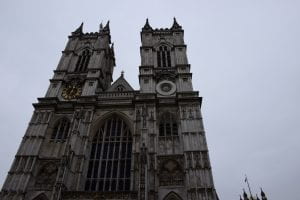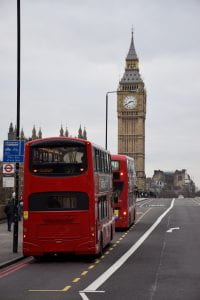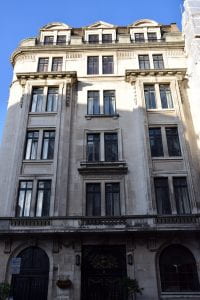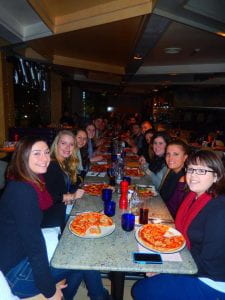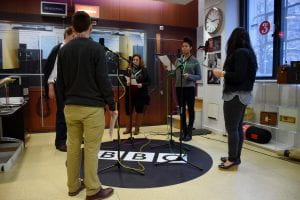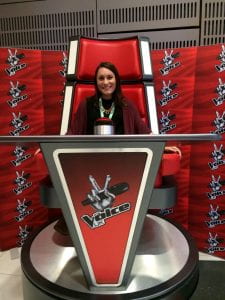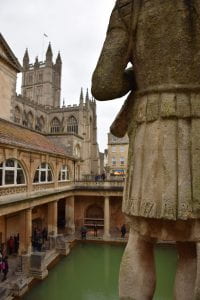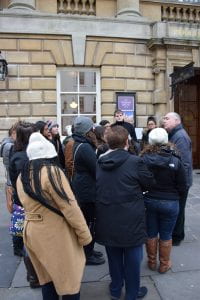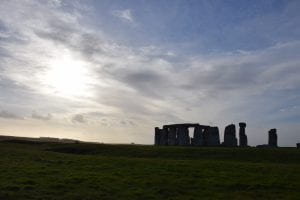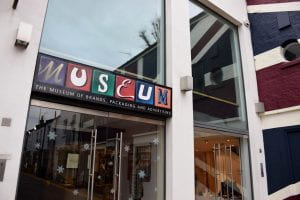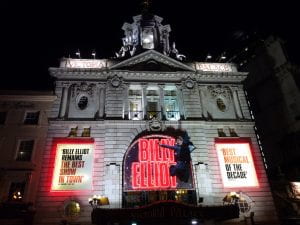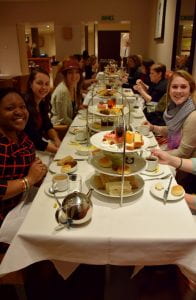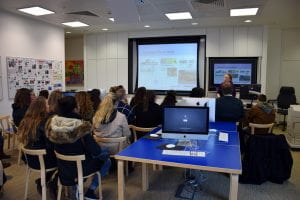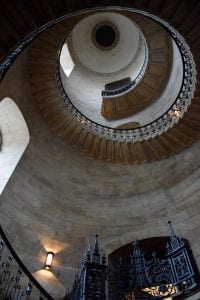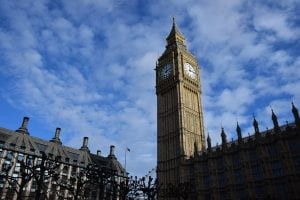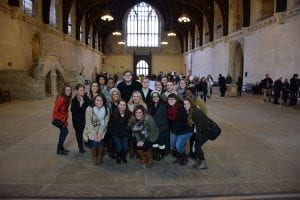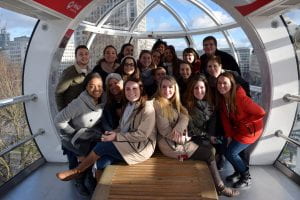A group of our best and brightest students made the decision to study abroad during this minimester to the UK! For many of these students, this is their first time in a foreign country, and they only have a limited amount of time to venture into the unknown and experience all that UK has to offer. Without a moment to spare, our students dived head first into the winter of their lives and have been learning and exploring nonstop. If you wish to live vicariously through them (I know we do), then keep up with this blog post and see what our students have been doing on a daily basis.
Towson’s Corporate Communication Group Takes London
Day 1:
After an uneventful flight, we arrived at London’s Heathrow to wait for the rest of the group. We then made our way into the city via a private coach and were dropped off at our spacious apartments. Upon settling in a bit, we ventured out for a short tour to acclimate ourselves to our new neighborhood. We were shown the nearest grocery stores, ATMs, Tube station, etc. Once our guide felt we were sufficiently acquainted with our new home away from home, she set us free! After a hot shower, unpacking, and battling the urge to sleep, the group met at Pizza Express for a ‘welcome to London’ dinner. While Pizza Express may not be the first thing you conjure up in your mind for typical London fare, it is a popular chain restaurant with delicious pizza. The group enjoyed the food and had a chance to get to know one other better!
Day 2:
We successfully navigated our way on the Tube and arrived at ‘campus’ for a general orientation session organized by the AIFS staff. They reviewed matters concerning health and safety, student services available, transportation options, and different cultural norms. After a lunch break, we were then shown all around town by a Blue Badge guide. To earn such a badge, one must study for a minimum of two years, and our guide had studied for four years. Obviously full to the brim with knowledge, she imparted a great deal of interesting information to the group. Thankfully it was a particularly quiet day for traffic, so we made our way all through the city on our private coach and made a few stops at St. Paul’s Cathedral, Tower Bridge, and the Globe Theatre. If only we could get her to meet us at a local pub to play trivia; we could dominate…!
Day 3:
The group met for class to discuss some logistical matters and share their impressions about their time in London thus far. From the sounds of it, students were teeming with comparisons and had already noticed a great deal of differences between the American and British cultures in just two, short days. After a lunch break, we listened to our first guest lecturer, Iain Swan, who discussed experiential marketing. It’s a rather new concept in the world of communication, and it’s one that focuses on brands needing to use a brand experience to create a vivid and valued experience for its consumers in order to be successful. He outlined several factors that he deemed to be imperative to utilize when trying to build a brand experience strategy and provided a lot of interesting examples to drive home his points.
Day 4:
Our next lecturer, Nicole D’Adamo, discussed British media. She started with a discussion about the BBC Broadcasting Network, which provided us with an excellent introduction as we toured the BBC later in the afternoon. We learned that the BBC aims to inform, educate, and then entertain viewers as the BBC’s number one goal is to provide a service to the public. Anyone owning a television in the UK must pay a license fee annually, and the fee is the principal means of funding for the BBC. We also discussed newspaper readership in the UK as 15% of population claims that their main platform for news is print. We were encouraged to pick up a few newspapers during our stay to bone up on current UK issues.
Our afternoon BBC tour reinforced the information given to us earlier in the day, and the group was given several opportunities to practice their communication skills. It seems that we have two potential news anchors in our midst as they flawlessly covered a story on the news. Others tried their hat on the radio as they partook in a murder mystery radio piece. It was a riveting and nail-biting tale that included eerie sounds effects. We also toured the main BBC newsroom, the “The One Show” studio, and the Royal National Theatre. I should also mention that we have a “The Voice” judge in our group as well – let’s hope she has a winning team.
Plus check it out: http://www.bbc.co.uk/iplayer/episode/b04vvplg/the-one-show-07012015. Prof. Turowski and students had an amazing, unplanned opportunity to be a part of a live viewing of the “The One Show.” They brushed shoulders with Emily Blunt, James Corden, and David Dimbleby – no big deal. * we found out the video is only live in the UK .. just know that it’s awesome!
Day 5:
Thursday was a busy sightseeing day! We started off in the rain and made our way to Westminster Abbey, a notable church for many reasons as we learned from our insightful guide. About 3,000 famous folks are buried here including a great deal of royalty including King Edward I and many other influential characters such as Charles Darwin, Geoffrey Chaucer, and Laurence Olivier. Westminster Abbey is not only a burial site, but it also has hosted some pretty big events in its day including several coronations like Queen Elizabeth’s in 1953 and a few royal weddings like that of Prince William to Catherine Middleton in 2011.
Thankfully the rain gave way to sunny skies, and we headed to the Tower of London to learn more about its past and to lust after the Crown Jewels. The tower is actually called Her Majesty’s Royal Palace and Fortress, and the Queen could technically take up residence here as it’s a palace, but we agreed that her other palaces are more suitable. The Tower has served many capacities during its prominent history. It’s been an armory, a treasury, a zoo, the home of the Royal Mint, a public records office, and as mentioned, it now houses the heavily secured Crown Jewels. Unfortunately, there was no good opportunity to stash the Koh-i-Noor diamond weighing in at 105 carats into a bag. Maybe next time…?
Day 6:
We split into two groups and one went to the Museum of Brands, Packaging, and Advertising while the other went on a ghost signs walking tour. Later in the day, the groups switched! The museum is located in lovely, Notting Hill and houses over 12,000 items that date as far back as the Victorian times. We walked down memory lane as the museum organized toys, foods, and household items by time period. It was neat to see how most brands have continued to use a particular logo that remains relatively the same today. There was also a section of the museum dedicated to packaging, and it outlined the strides in materials and efficiency of packaging of a wide array of goods over the past few decades.
So you may be wondering what ghosts have to do with communication as many of the students wondered the same thing! But alas, we didn’t go on a ghost tour. The tour focused on ghost signs, which are old advertising signs on the sides of buildings that have faded over time. Our guide, Sam, took us around Stoke Newington and explained the history behind many of the signs, which dated from the mid-1800s to the 1930s. The tour provided us with an interesting perspective on historical advertising, and some of the some elements remain relevant in today’s world. Since the tour, our group has noticed ghost signs throughout London and has tried to decipher them. Thankfully the students are young with good eyes since it can be quite difficult to read the faded lettering!
Day 7:
A free day! There was no itinerary – no early wakeup call – everyone was free to spend the day however they wished. Some of us explored more of the city making our way to Hyde Park, Kensington Palace, and Harrods while others ventured a bit farther afield to Windsor Castle to visit with the Queen. All in all, it was another busy day!
Day 8:
The group met early to make our way outside of London to visit Stonehenge and the city of Bath with our blue badge guide, Nigel. As we approached Stonehenge, we could see the impressive stones dotting the countryside. Archaeologists believe that Stonehenge was built anywhere from 3000 BC to 2000 BC, and while there is no written record dating to the site’s creation, a great deal of speculation surrounds its purpose. Numerous theories exist, but some claim that it was site where people celebrated the winter solstice; others argue that it’s a site of burial for the elite. It seems that its purpose will remain a mystery to us, but its grandeur will continue to inspire and awe visitors.
We then carried on to the city of Bath, which is UNESCO Word Heritage Site thanks to its rich history, beautiful architecture, and of course its Roman baths. All the buildings in the city are mandated to be built using the local limestone, which gives the city a consistent look. We drove through the city to get a sense of it and made a quick stop at the Royal Crescent, a row of 30 terraced houses, which is the best example of Georgian architecture in the UK. We then had some time to have lunch and explore the city a bit. At 2:45 sharp, we gathered at the entrance of the Roman bath for a tour of the complex. The baths, a Roman site for public bathing, have been well-preserved. The hot springs located here bubble up and produce about 250,000 gallons every day! The water isn’t safe to bathe in, but we were given an opportunity to sample clean water at the end. Many in the group were brave enough to try it, and we decided that it’s no Poland Springs water. The amount of minerals in the water gave it a rather unpleasant taste.
Day 9:
Back to the classroom we went! Our first lecturer of the day, Allison Lowe, discussed public relations (PR) specific to the fashion industry. The days of public relation agents only churning out press releases are over; today, PR compasses a great deal more. She provided us with a long list of opportunities, whether it be trade shows, installations, social media, or collaborations, to engage PR strategy as she says every interaction with a brand is public relations. She stressed the importance of persistence and patience as there are no guarantees that your pitch may be featured. It’s important to remain dedicated though for it can pay off. For the past 15 years, she has worked in the fashion industry, so it was interesting to hear some of her techniques for helping to promote young and upcoming high-end fashion designers. She also gave us a hot, new trend for men: the man skirt! I kid you not. It’s apparently a new look from last week’s London Collection: Mens. Let’s hope it takes a while for that trend to catch on…
Later in the afternoon, Justin Lorentzen, met with us to discuss British government. He outlined the role of the monarchy, the House of Commons, and the House of Lords. The Queen reigns but does not rule; the House of Commons is responsible for legislation; the House of Lords is the brain trust. We watched video clips from the opening of Parliament, which occurs every summer and is a good example of the relationship between the three bodies. The event is the commencement of a session of the Parliament, which includes a speech by the Queen. We’ll be able to walk the same halls later in the week when we tour the Houses of Parliament.
Day 10:
The day started with a lecture on organizational culture given by Paul Kyprianides. Having worked for both British and American companies, he compared the different approaches to organizational culture in each. He explained that class structure, while less prominent than it was years ago, is still quite prevalent in the UK. Because of this structure, a top-down management approach is very common in British companies. According to him, the structure in the U.S. is different as it is a consensus movement, which encourages people at all levels to be a part of the decision making process. Obviously each approach has its pros and cons, and we agreed that a combination of both approaches is likely to yield the best results.
Next up, we had a presentation by Julia O’Doherty from GDR Creative Intelligence. The company is an independent foresight agency specializing in retail, brand, and hospitality, and Julia shared a few trends, including branded downtime and cognitive computing. Basically, branded downtime is putting your brand in front of folks when they are just idling and passing time. She shared several clever examples, including the new Amazon Echo (if you haven’t seen this, check it out). Another fascinating trend is cognitive computing, which was designed to augment human expertise (i.e. Watson on Jeopardy). The question remains how brands will use cognitive computers to make them stand out from the pack.
After a long day of lectures, we hit up the West End and watched Billy Elliot at the Victoria Palace Theatre. We were memorized by the story and impressed with the dancing and singing talents of the cast. Several of us were moved to tears and left wanting to break out our dusty dance shoes!
Day 11:
First up, Alex Seago discussed the British Press and had us examine several different UK national papers. Through our examination, we were able to determine how class and political leanings play out in the different daily papers. One paper was geared toward the elderly population and was chock-full of medical equipment advertisements; another targeted female readership with a conservative but feminist slant. Each paper caters to different groups, and which paper you read says a lot about your social class and political thoughts. We can’t wait to ride the Tube and decipher everyone’s background based on the paper in their hands.
We then made our way to Bacchus PR, a creative agency that offers services and expertize in public relations. Our presenters shared a bit about working at the firm and gave a few examples of life as a restaurant PR specialist. An obvious perk of working with this firm is the fact that they have an office pet: an older, sweet greyhound.
Part of the study abroad experience is experiencing the local culture. Nothing screams British culture louder than afternoon tea. We met at Scoff & Banter for tea (breakfast, Earl Grey, or green) and sampled many different sandwiches, scones, and sweets. While it certainly wasn’t tea with the Queen, it was a memorable experience, and we all left stuffed and contented.
Day 12:
Another part of the study abroad experience is the study. The day started with a short answer exam that focused on the material covered thus far in the program. Reactions were mixed, but most students felt they did pretty well. Let’s hope the test scores reflect that!
Our final lecturer, Phil Woodford, met us in the afternoon to talk about Marketing Communications. He discussed different models of communication and stressed the importance of two-way communication; without two-way communication, a marketing campaign can only have limited success. We talked about the difficulties of monitoring your brand these days, especially with the growing dependence on social media. We looked at different examples of brands influencing other brands, which could be classified as collaboration as long as it’s a mutually beneficial agreement. He also questioned whether or not older forms of marketing communication, like TV commercials, are becoming obsolete. He provided us with excellent ideas and definitely left us with a lot to ponder.
Day 13:
The group met at St. Paul’s Cathedral for a guided tour, but we were told upon entering that we didn’t in fact have a guided tour. There was a grumble of disappointment amongst us because without a guide, we wouldn’t be able to see the spiral staircase that was showcased in one of the Harry Potter films. Prof. Turowski conferred with the guides again, and it turns out that they had confused us with ‘Tucson’ University. Relieved, we were quickly shown the impressive staircase. That wasn’t all that we saw though, and we learned about its history. After the Great Fire of London, the cathedral was rebuilt by Sir Christopher Wren. Influenced by his time in France, he wanted to build something different, something impressive. The signature dome certainly fit the bill, and it has remained a fixture of the London skyline for decades. Many in the group climbed the 500 steps to the top of the dome and were rewarded with beautiful views of the city.
After an afternoon class, we made our way to The Guardian newspaper headquarters. We were given a short presentation that covered the history and daily running of the paper. Claire Shaw, the deputy editor for the Guardian Higher Education Network met with us. She talked about her career path and discussed her work at the paper. Students were given the opportunity to ask questions, and we left with a copy of the paper to read through.
Day 14:
The day started with a tour of the Palace of Westminster, which is commonly known as the Houses of Parliament. Fire wreaked havoc not once but twice, and only the Westminster Hall remains from the 1834 fire. Charles Barry was hired to rebuild the palace, and he along with the help of others helped to create the gorgeous Gothic building that stands today. The Houses of Parliament are home to the House of Lords and the House of Commons. We toured both chambers and even saw the mark on the door caused by Black Rod during the commencement of a session of the Parliament. We were able to walk the halls of Parliament and have a deeper understanding of the dynamics between the monarchy, the House of Lords, and the House of Commons thanks to an earlier lecture by Justin Lorentzen.
We learned that the London Eye had been closed for the majority of January as it underwent a sponsor change; Coke Cola is now the proud owner. Thankfully for us and the throngs of other tourists, it reopened before our departure! A fire alarm delayed our flight time and caused major mayhem amongst the crowd. One of the students managed to corral our group onto a pod with great authority, and we took flight! The 30 minute flight allowed enough time for a plethora of selfies and groupies with London providing a stunning background. After two weeks of traversing the city, it was nice to see the city from way up high.
Day 15:
The only scheduled event on the itinerary was our farewell dinner, so many spent the day packing, buying last minute souvenirs, and exploring the rest of the places on their ‘to-see’ list. For supper, we dined at the Punch Tavern, which is apparently known as a steak and ale pie shop and gin palace. As far as I’m aware, there was no sampling of the gin, but many tried the one of the offered pies. During the meal, we reviewed the past two weeks and had a laugh or two. We discussed how quickly time had passed, and yet it seemed like forever since we’d seen our family and pets. We agreed that the program was great, but we were ready to head home.
Day 16:
It was up early to check out of our accommodations and board a private coach to the airport. Everyone was on time as it was clearly communicated that we would be leaving promptly at 7:30 regardless of whether or not we were all there. Understandably, one wanted to risk missing a flight, and we all left at 7:32. Despite some heavy traffic, we arrived in plenty of time to check-in and spend our last remaining pounds. Time to fly home and process the amazing experience!

